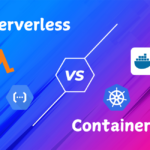In today’s fast-paced digital world, businesses are increasingly turning to cloud-native applications to achieve greater agility, scalability, and efficiency. But what exactly does “cloud-native” mean, and how does it shape the way we build and deploy modern applications? In this blog post, we’ll explore the key concepts behind cloud-native development, including the use of containers, Kubernetes, and serverless architecture, to help you understand why this approach is becoming the standard for building next-generation applications.
What Are Cloud-Native Applications?
Cloud-native applications are designed and built specifically to leverage the full potential of cloud computing. Unlike traditional applications, which are often migrated to the cloud from on-premises environments, cloud-native apps are purpose-built to operate in cloud environments. This means they are optimized for scalability, resilience, and flexibility, making them well-suited for dynamic and distributed cloud environments.
Key characteristics of cloud-native applications include:
- Microservices Architecture: Cloud-native apps are often composed of loosely coupled microservices, each responsible for a specific piece of functionality. This modularity allows for independent development, deployment, and scaling of each service.
- Containers: Containers are lightweight, portable units that bundle an application’s code along with its dependencies, enabling consistent execution across different environments.
- Orchestration with Kubernetes: Kubernetes is a powerful tool for automating the deployment, scaling, and management of containerized applications, ensuring they run smoothly in cloud environments.
- Serverless Computing: Serverless architecture allows developers to build and run applications without managing the underlying infrastructure, enabling faster development and reduced operational overhead.
The Building Blocks of Cloud-Native Applications
- Containers: The Foundation of Cloud-Native Development
- What Are Containers? Containers package an application’s code, along with its libraries, dependencies, and configuration files, into a single unit that can run consistently across any environment. This encapsulation ensures that the application behaves the same way, whether it’s running on a developer’s laptop, in a test environment, or in production.
- Benefits of Containers: Containers provide several advantages, including:
- Portability: Applications packaged in containers can easily be moved across different environments without compatibility issues.
- Isolation: Containers isolate applications from each other, ensuring that issues in one container don’t affect others.
- Efficiency: Containers are lightweight and require fewer resources than traditional virtual machines (VMs), allowing for higher density on a single host.
- Kubernetes: Orchestrating Cloud-Native Workloads
- What is Kubernetes? Kubernetes is an open-source platform for automating the deployment, scaling, and management of containerized applications. It’s the de facto standard for container orchestration, used by organizations of all sizes to manage complex, distributed applications in the cloud.
- Key Features of Kubernetes:
- Automated Scaling: Kubernetes automatically adjusts the number of running containers based on the application’s current load, ensuring optimal performance.
- Self-Healing: Kubernetes monitors the health of containers and automatically restarts or replaces those that fail or become unresponsive.
- Service Discovery and Load Balancing: Kubernetes provides built-in service discovery and load balancing, ensuring that requests are routed to the appropriate containers based on their availability and health.
- Declarative Configuration: With Kubernetes, you can define the desired state of your application using configuration files, and Kubernetes will automatically maintain that state.
- Serverless Architecture: Building Without Infrastructure Management
- What is Serverless Computing? Serverless computing allows developers to build and run applications without managing the underlying infrastructure. In a serverless model, the cloud provider automatically provisions, scales, and manages the server resources needed to run the application.
- Benefits of Serverless Architecture:
- No Infrastructure Management: Developers can focus solely on writing code, while the cloud provider handles all infrastructure concerns.
- Cost Efficiency: With serverless, you only pay for the compute time your code consumes, which can lead to significant cost savings, especially for applications with variable workloads.
- Automatic Scaling: Serverless platforms automatically scale up or down based on demand, ensuring that your application can handle sudden spikes in traffic without manual intervention.
- Event-Driven Execution: Serverless functions are triggered by specific events, such as HTTP requests, file uploads, or database changes, making them ideal for building reactive, event-driven applications.
Advantages of Cloud-Native Applications
- Scalability
- Cloud-native applications are inherently scalable. Whether you need to handle a sudden surge in traffic or support long-term growth, the cloud’s elastic nature allows you to scale your application effortlessly. Microservices and containers make it easy to scale individual components independently, ensuring that resources are allocated efficiently.
- Resilience
- Cloud-native architectures are designed for resilience. By breaking applications into smaller, independent microservices, you reduce the impact of failures. Kubernetes enhances this resilience by providing self-healing capabilities, automatically restarting failed containers and redistributing workloads to healthy instances.
- Agility and Speed
- The modularity of cloud-native applications, combined with continuous integration/continuous deployment (CI/CD) pipelines, allows teams to iterate quickly and deliver new features faster. Serverless architecture further accelerates development by eliminating the need to manage infrastructure, enabling teams to focus on writing code that delivers business value.
- Cost Efficiency
- Cloud-native applications can be more cost-effective than traditional applications. Containers and Kubernetes allow for efficient resource utilization, while serverless architecture ensures that you only pay for the compute resources you actually use. This pay-as-you-go model can lead to significant savings, especially for applications with unpredictable or spiky workloads.
Challenges and Considerations
- Complexity
- While cloud-native architectures offer many benefits, they can also introduce complexity. Managing microservices, containers, and Kubernetes requires a deep understanding of distributed systems. Additionally, the shift to cloud-native may require a cultural change within your organization, as teams adopt new tools and practices.
- Security
- Security in a cloud-native environment is different from traditional security models. With a larger attack surface, securing containers, Kubernetes clusters, and serverless functions requires a comprehensive approach that includes network segmentation, role-based access control, and continuous monitoring.
- Cost Management
- While cloud-native architectures can be cost-efficient, they also require careful cost management. Misconfigurations, over-provisioning, or lack of monitoring can lead to unexpected expenses. Implementing cost management tools and practices is essential to avoid budget overruns.
Conclusion
Building cloud-native applications represents a fundamental shift in how we design, develop, and deploy software. By leveraging containers, Kubernetes, and serverless architecture, you can create applications that are scalable, resilient, and agile, enabling your business to respond quickly to changing market demands.
However, adopting a cloud-native approach is not without its challenges. It requires a strategic commitment to embracing new technologies and practices, as well as a focus on security and cost management. By understanding the core principles of cloud-native development and carefully planning your transition, you can unlock the full potential of the cloud and build applications that drive innovation and growth.
Cloud-native is not just a trend—it’s the future of application development. Are you ready to make the leap?


